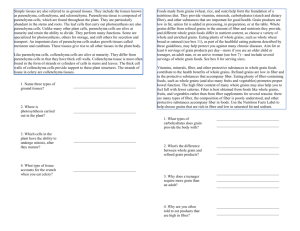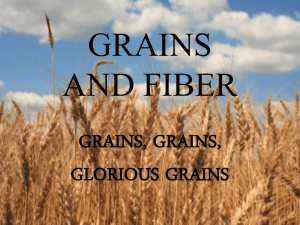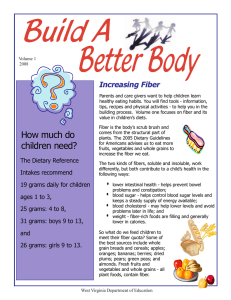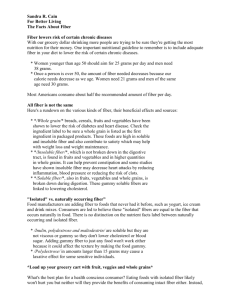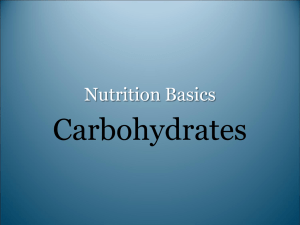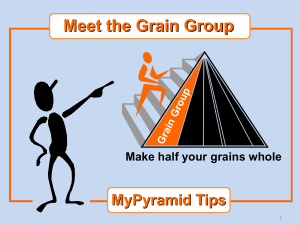Fruits Vegetables & Fiber
advertisement
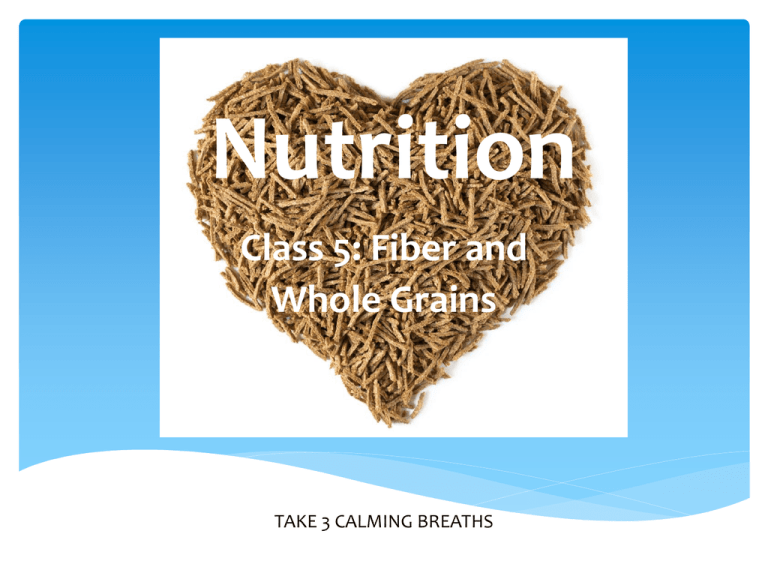
Nutrition Class 5: Fiber and Whole Grains TAKE 3 CALMING BREATHS Aids in digestion by adding bulk and “roughage”. Parts of plant foods that your body can’t digest or absorb. It passes relatively intact through your stomach, small intestine, colon, and out of your body. Helps maintain a healthy weight. Lowers risk for diabetes and heart disease. Soluble vs. Insoluble Fiber Soluble fiber. This type of fiber dissolves in water to form a gel-like material. It can help lower blood cholesterol and glucose levels. Found in oats, peas, beans, grains, rye, apples, citrus fruits, carrots, and barley. Insoluble fiber. This type of fiber promotes the movement of material through your digestive system and increases stool bulk, to aid with constipation or irregular stools. Found in fruits and vegetables such as cauliflower, green beans and potatoes, Whole-wheat flour, wheat bran, nuts, and beans. Most foods have a combination of soluble and insoluble fiber. What’s your guess? How much fiber, in grams, do you think the average American gets in a day? What do you think the daily recommendation for fiber is? Women? Men? Increase fiber in your diet gradually to ease digestive discomfort This is just a minimum recommendation; this amount can be exceeded. Fiber Supplements Fiber is best through whole foods in your diet – because they also provide many other health benefits. Fiber supplements come in a wide variety of forms and flavors -- from powders, oils, and wafers to capsules and chewable tablets. They are usually made from “functional” fibers, which is fiber that is isolated or extracted from plants or animals. Too much can cause loose stools, abdominal discomfort, gas, and bloating. Possible drug interactions – talk with your doctor before taking. Psyllium – Effective in treating constipation and the symptoms of irritable bowel syndrome. Best to EAT the FOOD rather than take supplements. Carbohydrates We do need Carbohydrates. Carbs have glucose which provides energy to our muscles, tissues, and brain. Carbs are found in foods derived from plants and dairy. Simple vs Complex Simple Carbohydrates have single or double sugar molecules bound together, allowing for quicker digestion and entrance into the blood stream and cells. Complex Carbohydrates(Also referred to as starches) have 3 or more sugar molecules bound together, allowing for slower digestion. Foods often contain a combination of the two. Simple Carbohydrates Found in processed and refined foods. Candy Syrups “White” breads and pastas Refined crackers, cereals, etc. Naturally occurring in fruits, dairy, and some vegetables. Complex Carbohydrates Naturally occurring in: Legumes Vegetables Whole grains Wheat, oats, brown rice, etc. Whole grain products Whole grain breads, pastas, etc. All grains begin as whole grains. In their natural state growing in the fields, whole grains are the entire seed of a plant. This seed (which industry calls “kernel”) is made up of three key parts: The bran, the germ and the endosperm. What happens when a grain is refined? Whole grains contain all three parts of the kernel. Refining normally removes the bran and the germ, leaving only the endosperm. Without the bran and germ, about 25% of a grain’s protein is lost, along with at least seventeen key nutrients. http://www.wholegrainscouncil.org/ 100% Whole Wheat or 100% Whole Grain Breads. 100% Whole Wheat pastas, couscous, orzo, amaranth, barley, brown rice, and pasta. Buckwheat, bulgur, corn (popcorn), cracked wheat (As a single ingredient) and farro. , Kamut, millet, oats, quinoa, rye, spelt, sprouted grain, teff and wheat berries. What Does a Serving of Whole Grain Look Like? 1/2 cup cooked brown rice or other cooked grain 1/2 cup cooked 100% whole-grain pasta 1/2 cup cooked hot cereal, such as oatmeal 1 ounce uncooked whole grain pasta, brown rice or other grain 1 slice 100% whole grain bread 1 very small (1 oz.) 100% whole grain muffin 1 cup 100% whole grain ready-to-eat cereal You can count a serving of whole grains as 16 grams (16g) of whole grain ingredients. What about Fruit Juice? Fiber? Whole food is best! 1 Serving of juice – 4oz Obesity? It’s in the fiber! Increased volume=satiety “apple” study Copyright 2009 ThedaCare Drinking Enough WATER Helps with passage of fiber, which absorbs water Water is lost with perspiration, urine, and breath Lubricates If you are thirsty – you are already dehydrated Men – 3 Liters (13 cups) Women – 2.2 Liters (9 cups) Handouts Getting to Know Grains
